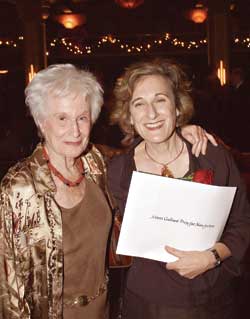Choice words from Sherry Simon

Sherry Simon celebrated her win at the Quebec Writer’s Federation award gala at the Lion d’Or with her mother, artist Shirley Berk Simon.
photo by monique dykstra
Sherry Simon sees her native city through the prism of its languages. Translation is a powerful lens for the professor of French studies, whose most recent book, Translating Montreal: Episodes in the Life of a Divided City, won the non-fiction category of the Quebec Writer’s Federation’s annual awards on Nov. 22.
From her graduate studies in Paris under future superstar Roland Barthes — and even before that, when she took buses to explore Montreal’s east end — Simon has been fascinated by how writers choose their words. As she shows in her book, they run the gamut from poet Frank Scott’s noblesse oblige and journalist Malcolm Reid’s edgy explorations of terra incognita to the playfulness of writers like Jacques Ferron, who invented hybrid words like farouest and quickelounche.
“Writers have invaded the domain of translation and wreaked a salutary havoc,” Simon writes with satisfaction. “Montreal has become a laboratory for the interlingual imagination.”
The phenomenon extends to languages other than English and French. She pays particular attention in her book to the struggles of the great poet A.M. Klein, the first Canadian writer to assert his Jewish identity through the use of English.
One of the most exciting trends she spots is toward cosmopolitanism among Québécois writers and translators. Pierre Anctil, who is not Jewish, translates Yiddish writers into French. Jacques Brault started out as a nationalist writer but blossomed into an experimenter, writing about and under the influence of European and Asian writers. Michel Garneau does controversial translations of Leonard Cohen and William Shakespeare into French.
Moreover, English-speaking writers are using their Quebec identity in unexpected ways, writing in French or even composing “translations without the original.” However, Simon cautioned in an interview, this would not have been possible had Montreal remained the uneasily bifurcated place it was when she was growing up.
“The New Anglo is only possible because this is [now] a French city,” she said.
At the core of her teaching and her books is the observation that every translation is a rewriting of the original and a new work of art. She speaks with approval of translators like Chicago-born David Homel, whose rendering of How to Make Love to a Negro is in fact wittier than Dany Laferrière’s original hit in French.
She said there had been a tradition of literary translation in Canada, mainly from French to English. However, most of the translation that was done was administrative and commercial, and went mainly from English to French because the English were the dominant language group.
All that changed in the 1980s. Translation simply took off around the world, and gave rise to a form of academic self-regard called translation studies. “It became a very big field with a lot of voices,” Simon said. She teaches translation studies in the master’s program and an introductory course in translation itself.
One of the pitfalls of being a Montrealer, apparently, is being almost too bilingual, the sort of person who switches effortlessly back and forth. She has learned to be wary of students who think they’ll make great translators because they speak English and French equally well.
In fact, the best translators have a profound knowledge of their own language, and write it best. “They also have to have excellent knowledge of French, but hopefully not to the extent of interfering with their English.”
Simon did her PhD at the Université de Montréal in French literature, and came to Concordia to teach in the Departement d’Études françaises in 1983, becoming full-time in 1987.
“I’ve always loved this department and this university,” she said. “Now there’s a sense of renewal in the department, and a nice spirit of dynamism.”